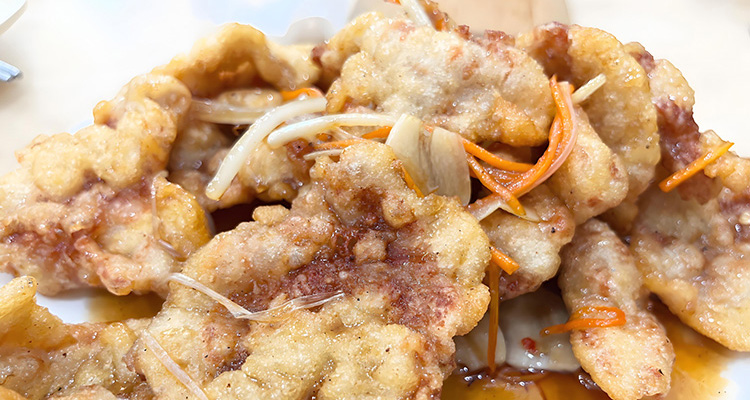Guo Bao Rou: Crispy Sweet & Sour Pork Delight
1. Origins of Guo Bao Rou
Guo Bao Rou, also called Sweet and Sour Pork, is a famous dish from Northeast China.
It originated in Harbin during the late Qing Dynasty. Chef Zheng Xingwen created it for Russian guests.
He adapted traditional fried pork slices with a sweet and sour flavor.
Over 100 years, it became a signature Dongbei dish.
It blends Chinese cooking with Western influences perfectly.
Eating Guo Bao Rou is not just food—it’s a taste of history.
2. Cultural Significance
In Northeast China, Guo Bao Rou is a symbol of warmth and hospitality.
It is a must-have dish for family gatherings and festive meals.
This crispy sweet and sour pork shows the host’s respect for guests.
It represents the hearty, generous spirit of Dongbei people.
Sharing a plate gives a sense of community and local culture.
Guests often remember the flavor and friendliness long after the meal.
3. Ingredients and Special Features
Main ingredients include pork tenderloin, potato starch, vinegar, sugar, and soy sauce.
Ginger, carrots, and scallions add aroma and light sweetness.
Potato starch ensures a golden, crispy exterior.
Pork tenderloin is tender and lean with no greasy taste.
The combination creates a perfect balance of sweet, sour, and lightly roasted flavor.
Even simple ingredients can make an unforgettable dish.

4. How to Make Guo Bao Rou
Start by slicing pork tenderloin evenly.
Coat each slice with potato starch for a crisp finish.
Heat oil to medium-high and fry pork twice:
- First fry: set shape, lightly golden.
- Second fry: golden and super crispy.
Prepare sauce with vinegar, sugar, and soy sauce.
Quickly toss fried pork in sauce for even coating.
The whole cooking process takes only a few minutes.
Result: crispy outside, tender inside, and a shiny sauce layer.
5. Flavor and Texture
The golden crust cracks loudly when bitten.
Inside, the pork is juicy and tender.
The sweet and sour sauce is balanced, not too sweet or sour.
First, you taste the tangy punch, then a sweet aftertaste.
It feels like a dance of ice and fire in your mouth.
This crispy sweet and sour pork creates a multi-layered taste experience.
6. Serving Suggestions
Eat Guo Bao Rou with hot white rice for a classic experience.
Alternatively, try it plain first, then dip lightly in sauce.
This way, the pork flavor and sauce merge perfectly.
Pair it with local beer to feel the authentic Dongbei style.
Enjoy each bite immediately for maximum crispiness.
It is simple, satisfying, and hard to stop eating.

7. Where to Try Authentic Guo Bao Rou
Harbin’s Lao Chujia is a historic restaurant serving classic Guo Bao Rou.
Dongfang Jiaozi Wang offers delicious dumplings and this signature dish.
In Shenyang, try Li Lian Gui Xunrou Dabing for traditional Northeastern flavors.
Average cost per person: 30–80 RMB.
Order by saying: “来份锅包肉” (Lái fèn guō bāo ròu).
One plate usually serves 2–3 people; eat while hot.
8. Traveler Tips
Guo Bao Rou in English: “Sweet and Sour Pork” or “Guo Bao Rou.”
Eat within 5 minutes of serving for the crispiest texture.
Pair it with local beer for a hearty meal.
Capture its golden color for photos—it’s very photogenic.
Visiting Northeast China? Add this dish to your must-try food list.
9. Home Cooking Version
Slice pork tenderloin and coat with corn starch.
Fry until golden for a simple homemade version.
Sauce: combine vinegar, sugar, and a little ketchup; bring to boil.
Toss fried pork in sauce and mix evenly.
Optional: wrap pork with lettuce leaves instead of rice.
It may not be restaurant-perfect, but it’s fun and tasty.

10. Why You Must Try Guo Bao Rou
This dish is more than food—it’s a flavor journey.
It introduces Northeast China’s icy landscapes and hearty culture.
The crispy sweet and sour pork becomes a highlight of any trip.
Every bite combines texture, taste, and tradition.
Adding it to your travel list guarantees a memorable culinary experience.


